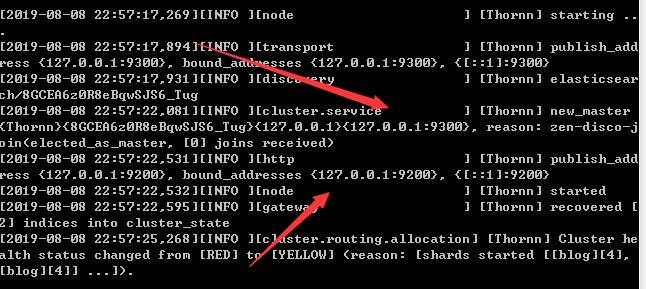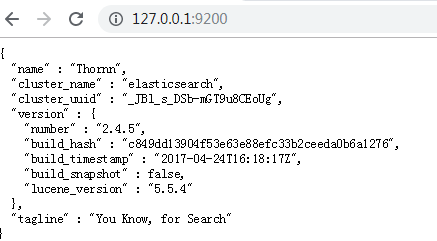ElasticSearch基于Lucene的搜索服务器,支持分布式,提供REST接口,可用于云计算,可以实现实时搜索,开源免费。这时很官方的一句话,在使用之前,我们简单的介绍一下安装过程。在官网下载之后,直接解压出来,找到bin文件夹下,运行elasticsearch.bat,运行后的结果如下:

程序的连接端口是9300,服务器的管理端口是9200。运行之后看结果,则在浏览器上输入127.0.0.1:9200,显示如下:

这样表示es已启动,为了更加直观,可以安装插件,即图形化管理工具:下载esHead插件,解压之后,放到 es的plugins文件夹下,文件名为head即可,后重启服务器,输入http://127.0.0.1:9200/_plugin/head,出现如下界面表示安装插件成功:

安装完成之后,下面简单介绍索引的创建和删除:
首先创建maven工程,引入相应的坐标:
<?xml version="1.0" encoding="UTF-8"?> <project xmlns="http://maven.apache.org/POM/4.0.0" xmlns:xsi="http://www.w3.org/2001/XMLSchema-instance" xsi:schemaLocation="http://maven.apache.org/POM/4.0.0 http://maven.apache.org/xsd/maven-4.0.0.xsd"> <modelVersion>4.0.0</modelVersion> <groupId>com.es.demo</groupId> <artifactId>elaticsearchdemo</artifactId> <version>1.0-SNAPSHOT</version> <name>elaticsearchdemo</name> <!-- FIXME change it to the project's website --> <url>http://www.example.com</url> <properties> <project.build.sourceEncoding>UTF-8</project.build.sourceEncoding> <maven.compiler.source>1.7</maven.compiler.source> <maven.compiler.target>1.7</maven.compiler.target> </properties> <dependencies> <!-- ElasticSearch core --> <dependency> <groupId>org.elasticsearch</groupId> <artifactId>elasticsearch</artifactId> <version>2.4.5</version> </dependency> <dependency> <groupId>junit</groupId> <artifactId>junit</artifactId> <version>4.12</version> </dependency> <dependency> <groupId>com.fasterxml.jackson.core</groupId> <artifactId>jackson-core</artifactId> <version>2.8.1</version> </dependency> <dependency> <groupId>com.fasterxml.jackson.core</groupId> <artifactId>jackson-databind</artifactId> <version>2.8.1</version> </dependency> <dependency> <groupId>com.fasterxml.jackson.core</groupId> <artifactId>jackson-annotations</artifactId> <version>2.8.1</version> </dependency> </dependencies> <build> <pluginManagement><!-- lock down plugins versions to avoid using Maven defaults (may be moved to parent pom) --> <plugins> <!-- clean lifecycle, see https://maven.apache.org/ref/current/maven-core/lifecycles.html#clean_Lifecycle --> <plugin> <artifactId>maven-clean-plugin</artifactId> <version>3.1.0</version> </plugin> <!-- default lifecycle, jar packaging: see https://maven.apache.org/ref/current/maven-core/default-bindings.html#Plugin_bindings_for_jar_packaging --> <plugin> <artifactId>maven-resources-plugin</artifactId> <version>3.0.2</version> </plugin> <plugin> <artifactId>maven-compiler-plugin</artifactId> <version>3.8.0</version> </plugin> <plugin> <artifactId>maven-surefire-plugin</artifactId> <version>2.22.1</version> </plugin> <plugin> <artifactId>maven-jar-plugin</artifactId> <version>3.0.2</version> </plugin> <plugin> <artifactId>maven-install-plugin</artifactId> <version>2.5.2</version> </plugin> <plugin> <artifactId>maven-deploy-plugin</artifactId> <version>2.8.2</version> </plugin> <!-- site lifecycle, see https://maven.apache.org/ref/current/maven-core/lifecycles.html#site_Lifecycle --> <plugin> <artifactId>maven-site-plugin</artifactId> <version>3.7.1</version> </plugin> <plugin> <artifactId>maven-project-info-reports-plugin</artifactId> <version>3.0.0</version> </plugin> </plugins> </pluginManagement> </build> </project>
然后创建测试类,创建客户端对象,利用对象创建索引和删除索引,代码如下:

创建索引之后,可视化根据中出现:

表示索引成功,删除索引代码如上所示,同理。介绍完了索引的创建和删除,下面看看es的映射规则是怎么操作的: